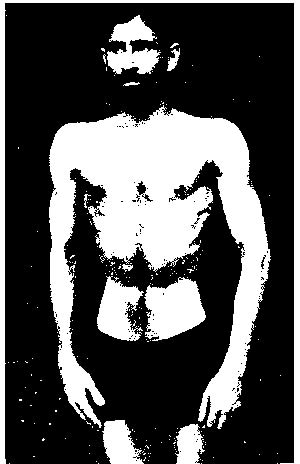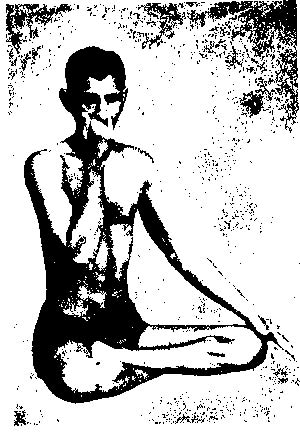Pranayama: Yoga Methods of Breathing

The exercises recommended herein represent merely the initial stages in the scientific study of Pranayama or yoga breathing, and have been selected for their simplicity. They are, however expected to fulfill the requirements of an average person and are quite adequate to meet the general need for respiratory hygiene. The higher technical yoga processes are more or less complicated, and their technique is not so easily understood without the guidance of a practical teacher. Such exercises have to be omitted purposely from this volume.
Sunyaka
This process of respiratory standstill consists of the absolute suspension (Sunyaka) of breath even after a forced exhalation and may be termed vacuum breathing. It is practiced thus:
Secure siddhasana or padmasana as convenient, or the yoga breathing is performed most comfortably in a sitting position. Keep the body above the waist straight and the spine erect. Now take in a normal deep breath; and, when the inhalation is complete, exhale slowly and with case. Make an effort to completely empty your lungs of the air-contents. Remember to throw breath out in one long, continuous and forceful rhythm. Keep on exhaling till the last volume of air is out and you begin to feel that you cannot exhale any more. When this stage is reached, draw up the abdomen in towards the spine. Maintain this state with the suspended breath, i.e., do not cither inhale or exhale. Keep this up for about five to ten seconds, then slowly begin to inhale until you get to the normal rhythm of breath. Repeat this vacuum breathing five to ten times once in a day-best followed in the morning.
This process is considered extremely useful for weak stomach and sluggish colon, besides being a corrective for inflated lungs and tachycardia. Those with serious heart affections and pregnant women should avoid this method. Also children under the age of twelve years should be precluded from undertaking its practice.
Puraka
This process of Pranayama consists of absolute and continuous inspiration (puraka) and maybe termed the packing breath. Maintain the same position as in the previous exercise. After normal exhalation, begin to inhale slowly and rhythmically in one long, slow and unbroken inspiration. Continue this till you feel a sense of fullness in your chest as in forced respiration. Remember to keep the abdomen controlled during the entire period of inhalation. Now, without retaining the breath, gradually exhale, avoiding jerks or hasty movements; and repeat.
Concentrate your attention on the time taken during the period of inhalation. This should be prolonged as far as possible, i.e., beginning from five seconds to ten seconds. The objective is to lengthen the period of inhalation so as to allow the maximum in - take of air with ease and without injuring the lungs. This is best achieved by beginning the act of inspiration slowly and rhythmically, taking enough time to complete the process, instead of drawing the breath in all at one time, or within a short period. Practice this method of absolute inhalation five to ten times once in a day.
It may be observed that this Pranayama breathing is very helpful to those whose lung capacity or heart action is poor. It forces open every disused air - cell in the lungs and stimulates the sluggish ones to healthy action. During extra breathing, if the expansion of the lungs is made to coordinate, through prolonged inhalation, with the speed of assimilation, the hygienic benefits correspond to those during swimming.
Kumbhaka
This process of Pranayama aims at mere retention {kumbhaka) of the inhaled air, generally termed sahita kumbhaka or inspiratory standstill. Thus, having taken in a deep breath as suggested in the previous exercise, try and retain the inhaled air for a period of ten to twenty seconds�more preferably double the period of inspiration. That is, if the act of inspiration has taken five seconds, the retention should be for not less than ten seconds and so on accordingly.
For one thing, do not allow the abdominal muscles to relax but keep them controlled, i.e., held in normal contour, during the entire process of breathing. The controlled abdomen during absolute retention of breath. For another, check even the slightest tendency to either inhale or exhale during retention, and maintain a passive state of "a bag full of air". After the due period of retention�in the ratio at suggested above - begin to exhale slowly, and repeal. For the beginners, it is advisable that the process be followed for only five times a day and increased to ten times gradually.


The hygienic effects of conscious retention of breath after a forced inhalation with controlled abdomen arc quite marked upon, what are termed, the dead space-air and also upon the alveolar air, facilitating better ventilation due to favorable changes in the intrathoracic and intrapulnomic pressures than is otherwise possible. Bernard and Mantoux have shown (Factor of Safety) that the possibility of increase in the depth of respiration is nearly 400 to 500 per cent, and that, after a very deep inspiration, the retention of breath, causing necessary increase in the amount of carbon dioxide, stimulates the respiratory centers to a considerable interchange of oxygen during the internal respiration - in contrast to the reverse process which takes place in the lungs. This, according to Roscnau also establishes the regulation of breath by a continuous rather than an irregular and interrupted function of respiratory movements. And this is precisely what the yogin proposes to achieve through habituation to conscious and prolonged retention of breath2'5 for health, longevity and concentration. Kumbhaka also reduces strain on the circulatory system.
Recaka
This practice in Pranayama consists of absolute exhalation (recaka). Thus, having retained the breath, as shown in the previous exercise, try to exhale slowly and in one long continuous rhythm. The object of this exercise is to lengthen the duration of exhalation with a view to facilitating maximum supplemental air. This can be achieved only by allowing the breath to escape in a very slow and small measure much in advance of time, i.e., before a forceful and hasty exhalation becomes a necessity. Try to adjust the time of both the inhalation and retention in such a way as to leave enough margin of time for a complete and prolonged exhalation. For a man of average constitution, the time necessary to complete such an act of either inhalation or exhalation should be not less than five to ten seconds.
Various control experiments conducted on forced expiration with controlled abdomen show that apart from the corresponding pressure changes, a further quantity of air, about 108 cubic indies or 1728 c.c. approximately (Yogendra and Hack),is expelled through deep and prolonged exhalation besides the ventilation gained through normal expiration. Physiologists confirm that the air thus expelled by a forceful deep expiration consists of air from the alveoli. It means that, during recaka as practiced above, a larger volume of carbon dioxide is eliminated from the lungs than is possible under normal exhalation. Yoga believes that the restoration of diaphragmatic function is superior in ventilatory effectiveness than ordinary breathing (Barach).
Anulomariloma Breathing
It is a matter of general observation that every human being inhales and exhales for a certain period - approximately an hour and a half - through the right nostril and then automatically and unconsciously changes to the left for a like period. Yoga maintains that it is really the effort of Nature towards equibalance of the positive and negative effects of breath both on the body and the mind. That such harmony produced by alternate breathing will considerably aid, through equilibration, the general tone of the respiratory organs is easily realized. The special feature of certain methods of yoga breathing or Pranayama, therefore, consists in the alternate use of the right and the left nostril to regulate the varied effects of breath on the body and mind.
Sitting comfortably in any one of the two postures as recommended previously, inhale deeply, as in puraka, through the right nostril closing the left one. Use the thumb and the little linger for closing the right and the left nostril respectively and alternately. Then, maintain kumbhaka - according to one's capacity or as per the ratio commended previously - and exhale slowly through the left nostril closing the right one. Reversely, drawing in the air through the left, nostril, the lungs should be filled slowly as before and, after retaining the same for a like period; it should be exhaled as in recaka through the right nostril. Inhaling thus through the one through which it was exhaled and having retained it there as long as possible, it should be exhaled gently and deeply through the other.
In fact, the complete round of yoga alternate breathing consists of: (i) expiratory standstill before undertaking deep breathing, (ii) inhalation through the right nostril, (iii) inspiratory standstill according to ratio, (iv) exhalation through the left nostril, (v) inhalation also through the left nostril - immediately following the previous deep exhalation through the same nostril, (vi) inspiratory standstill according to ratio, (vii) exhalation through the right nostril, and (viii) expiratory standstill before undertaking another round of pranayama.
Practical students of Yoga may be cautioned, especially with regard to the time-measure in yoga breathing, that the minimum numerical proportion of duration in the three important processes of breathing, viz., puraka, two - fold kumbhaka, and recaka, be regulated in the ratio of 6 : 8 : 5 (Goraksa). Optionally, expiratory standstill may be of the same duration as the period of inhalation. This can be easily achieved by following mental counts, the repetition of Om, the chanting of gayatri or the sacred formula, and, for greater accuracy, the use of a watch. The relative time taken by each act is likely to vary with every individual but, at the lowest estimate, the same should be adjusted on the following basis :(i) expiratory standstill, 2 seconds ; (ii) in halationthrough the right nostril, 2 seconds ; (iii) inspiratory standstill, 3 seconds ; (iv) expiration through the left nostril, 2 seconds ; (v) inhalation through the left nostril, 2 seconds ; (vi) inspiratory standstill,7 seconds ; (vii) exhalation through the right nostril,2 seconds ; and (viii) expiratory standstill, 2 seconds. The total time thus required for one round of complete yoga breathing is about 20 seconds or three breaths per minute. The psychosomatic affects of this process are sedative first 011 the ton, volume and rhythm of the heart and second on the brain waves.






